|
|
PMCC - Magazine 326 Friday 1st April 2022 |
|
Uncovering our past to preserve for the future
|
|
PMCC - Magazine 326 Friday 1st April 2022 |
|
|
Editor - Norman Woollons |
|
James Treversh - Design |
|
Click on article title |
Editorial | Head Dress | ||
| Black and White | Humour | |||
|
|
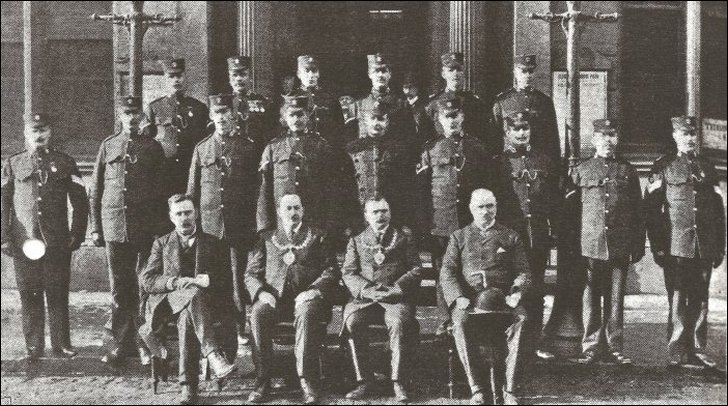

|
The Air Beat Never throw anything away! |
|
I am sure that every member send him your best wishes.
Here's a thought! What do you do with your collection? Do you display it? Is it locked away? Or are you like our member Ross Mather who has a Virtual Museum of Welsh Policing? Does your Minister of the Interior let you have space for some things to be on display?
I have always been and remain passionate about police history:
Like the motto of the PMCC I am preserving the past for future generations. Our history is the foundation on which the present is built.
This is why history matters.
We would like you to share a photograph, whether it is of your prize item or a larger selection, it doesn't matter, but the time is now to let others see what it is that we hold so precious.
Norman |
|
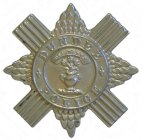
|
From The Hull Mail, November 9, 1909 |
Passing of Lieutenant David Lamb, Dundee City Police |
|
Mr Lamb was a native of the north of Fife, he having been born near Gauldry, in the parish of Balmerino. Reared in a rural district, he was early sent to work with the farmers. Like most of the boys in his station of life, he received only the mere rudiments of education. After working as a farm servant on various farms in the north of Fife, he came to Dundee and joined the police force on 29th April 1864, when quite a young man. There were fewer inducements to enter the police service then than are nowadays. The pay was small and the duty was harder, with few Sundays off and no holidays. To an active, intelligent man however, promotion was sure. Mr Donald Mackay, the superintendent was not slow to appreciate merit, and he soon discovered that Constable Lamb possessed all the necessary qualifications necessary to make an efficient officer. Mr Lamb began his service as night constable, but he speedily rose in the estimation his superior officers. From night duty he was transferred day duty and thereafter he was promoted to the rank of sergeant. His aptitude for detective work early developed itself.
The city was infested by gangs of daring and desperate thieves and burglars, who committed many audacious and successful robberies. Mr Lamb made himself master of their ways and modes of operation, and he was instrumental in making some important arrests. He was soon transferred to the detective department, and ultimately to the head of the detective force, which he continued to control till he was laid aside in July last. As a detective officer Mr Lamb had a wide and varied experience. His keen insight into character was very remarkable and he seldom failed when a case was reported in fixing his suspicions on the right man. Night and day he was ever ready and willing to attend to the call of duty, and when serious cases were on hand he would spend night after night in searching the lodging-houses and dens in the vilest slums searching for thieves and stolen property. It was A LIFE OF EXCITEMENT AND ADVENTURE accompanied with much anxiety of mind and hardship and danger. The tact, perseverance and courage he displayed in the discharge of his duties formed the secret of his success. The most sensational cases which have come under his notice within the last five and twenty years were the Kingennie murder, the breaking out of Dundee Prison by Jenkins and Milton, and again more recently by Bremner; the Museum robbery, the Princess Street murder, the John Street tragedy, and many others of lesser note. Scobbie, the Kingennie murderer was ferreted out of lodging-house in Overgate by Lieutenant Hill, but Mr Lamb had also his share of work in connection with the case.
Hunting for Jenkins and Milton, the prison-breakers, was very exciting duty. These men, who were under sentence of penal servitude, had been confined together in consequence of the depressed mental condition manifested by Milton. They contrived to lift a flag stone in the floor of their cell, underneath which they discovered a tunnel that ran under the building and opened into the Governor's garden. By this means they escaped from the cell and gained the open air within the enclosure of the prison wall. From the garden they climbed to the roofs of the buildings, and, scrambling along in the darkness they came to the top of the gateway in Bell Street, where they lowered themselves to the ground aid of the rope attached to the flagstaff in the descent one of them hurt his leg, but his companion carried him his back to a secure hiding place in Hill town. The hunt was under the direction of Detective Lamb, and was conducted with energy and vigilance till Jenkins was at length unearthed. Milton got clear of the town and went to sea, and eluded capture for two years.
Under Mr Lamb the detective staff was thoroughly organised and rendered as efficient as any similar force in the kingdom. By the firm grasp he had over the dishonest classes, he succeeded in reducing very considerably that class of crime within the bounds of the city. When Mr Dewar succeeded Mr Mackay in the command of the force he found in Mr Lamb a trustworthy officer, and one on whom he could rely in every emergency. Between the chief and his subordinate a warm friendship existed which continued throughout the whole course of their official connection. On the death of Lieutenant Lyall Mr Lamb was promoted to the rank of Second Lieutenant and in May 1892, on the retirement of Deputy Superintendent Hill, after forty-one years' service, Mr Lamb was promoted to the position of Deputy Chief Constable and assistant Procurator-Fiscal in the Police Court. Notwithstanding the onerous nature of the duty that now devolved upon him, he still continued to control the detective department. He was genial and courteous in his manner to all with whom he came in contact, and even the unfortunate classes with whom he had to deal received every consideration his hands. He was a member of Chapelshade Free Church, he leaves widow, four sons, and a daughter all grown up, his oldest son, David, being a sanitary inspector for the county of Stirling.
|
|
What would you like to see? |
|
What would you like to see in the club magazine or on the website? Don't keep it to yourself. Let Norman or Jim know and we will do our best to publish your request. |
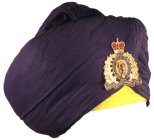
|
Head dress as a symbol |
|
If
you ask a foreigner what typifies the British Bobby, they will answer
"the helmet". It is also a singularly requested item of
memorabilia by overseas collectors.
Anyone lucky enough to have been able to see the competitive daily "Sunset" ceremony at the Wagah-Attari border gate, a border crossing between present day India and Pakistan will have seen the similarity ceremonial turban head dress worn by both armies.
When I received a police Turban, which came as a 'flat pack', I suddenly realised that I had no idea how to turn lengths of cloth and a cone shaped pagri, into the beautifully ornate police head dress.
There are several parts to a turban. I am using the name generically here, because what in English would be so described goes by man local and dialect names in different countries.
The Khulla is the cap which is worn especially by Muslims, but also forms part of the turbans worn accross the indian sub-continent.
The Shamla is the decorated pleated or folded cockade worn to the side of the head dress, as in this current Punjab Police turban.
The Khulla is in
gold thread in the centre.
There is no record of who the first Sikh police officer was, or even which force they joined and when.
They would have been in one of the large metropolitan forces where there was a big Asian population, somewhere like the West Midlands Police, West Yorkshire Constabulary or the Metropolitan Police. Or just perhaps one of the constituent forces from those areas, like Bradford City, Birmingham City or Wolverhampton Borough.
What there is no doubt about is that they would have been issued with a helmet. What has been recorded is the first person, a Special Constable in London, who wore a Turban as part of his uniform.
It was only in the early 1970's, when there was a push to recruit officers from the ethnic minorities, so the force makeup matched the local demographic profile, that a turban was allowed to be worn as an alternative to the traditional helmet.
I recall reading in the Police Review that this or that force was now allowing Turbans, but at the time had no inkling of the behind-the-scenes correspondence that was taking place over what was then a thorny issue.
The 1960's was a decade of change in the British Commonwealth countries. Many were seeking and obtaining independence from the British Empire. In East Africa, independence was granted to Kenya, Uganda, Tanganyika and Zanzibar in the early 1960's. Each time, a wave of Asians came to Great Britain.
From the very beginning of the migration, the incoming Asians mainly settled in London and the West Midlands, with smaller groups in West Yorkshire and the East Midlands.
Several of those who settled in London were Sikhs who had served in the Police services of the former East African Empire countries before or during independence.
The Colonial Police Services, administered by Britain had had Sikh police officers in them since the 19th century.
By 1965 a small number of these former Colonial Police Officers had joined the Metropolitan Police in London as Civil Staff. There were also a two Sikh Special Police Constables in the Met Police as well.
The first known application by a turban wearing Sikh, to join
Metropolitan Police Force was in January 1969. He was a former senior
Police Officer in Kenya.
In 1967 Norman Goodchild, the Chief Constable of the West Midlands Police asked the Home Office whether he should allow a Sikh, who wished to become a traffic warden in the city of Birmingham, to wear a turban instead of the regulation uniform cap. The Home Office in turn sought the views of the Commissioner of Metropolitan Police.
Sir Joseph Simpson, the Metropolitan Police Commissioner said in his reply in November 1967 that while he supported the proposal that Sikh Traffic Wardens should be permitted to wear turbans, "I am just as clear in my view about the possible extension of this to the police and in this respect I take the opposite view. Whatever the Uniform Committee may recommend to the Police Advisory Board, I shall take a very strong stand on the wearing of helmets in London".
The Home Office view was that it was "a simple matter, in isolation, to decide that Sikh traffic wardens should be allowed to wear a turban, because this accords with practice in the armed services and in the colonial police forces".
The then Home Secretary James Callaghan approved the wearing of Turbans by Sikh Traffic Wardens in the UK, in March 1968.
However, as it transpired, in January 1969 the Metropolitan Police received an application by a Sikh to join the police force and wear a turban because of his religious faith.
By then Sir Joseph Simpson had retired and the Commissioner was Sir John Waldron. He wrote to the Home Office on 10th February 1969 for a view saying, "Personally I am much against it, as I would be any other peculiarity which tended to make one policeman different from another."
"There would be certain duties such as patrolling on a motor cycle or taking part in demonstrations where a turban would be unsuitable because it would not provide the necessary protection."
"Prompt recognition by police or public in a crowd is essential; this a helmet provides. It would be inconvenient if any man accepted into the Force was restricted in the duties that he was able to do."
"For these reasons alone I consider that anyone who joins the Service, whatever his religion, race or ethnic origin may be, must dress in the standard uniform of the Force."
"In addition it might well produce strong objections from the Federation, who at the best are never anxious to accept applicants of foreign origin into the Service. There is a danger of ridicule. On the whole I think we must lay down that any man who wants to become a policeman must comply with the standard conditions".
The Home Office, after inter departmental consultations and having consulted Douglas Osmond (Chief Constable Hampshire Constabulary), President of Association of Chief Officers (ACPO) and Dick Pamplin, Secretary of the Joint Central Committee of the Police Federation, wrote to the Commissioner on 18th April 1969 that it was the Home Secretary's (James Callaghan) conclusion that it would be right to permit any Sikh who joins the police service to wear a turban.
The letter pointed out that "the Home Secretary fully appreciates the considerations mentioned in your letter but has come to the conclusion that, on balance, it would be right to permit any Sikh who joins the police service to wear a turban. He had in mind particularly that, although there is a case for insisting on uniformity of dress on a uniformed and disciplined service, the fighting services have found it satisfactory to accommodate Sikhs wearing turbans; and he does not think that the special considerations which apply in the police service -including the possibility that a man wearing a turban could not be employed on every aspect of police duty would outweigh the general desirability of putting no obstacle in the way of a Sikh recruit".
The applicant, a former police officer from Kenya , however, did not join the Metropolitan Police in the end as he had found other employment.
The Metropolitan Police Specials at that time did not wear the traditional police helmet. There was, however, a lot of media interest when he went out patrolling the streets of East London on 27 January 1970.
Around the same period, Ajmer Singh Matharu had emigrated from Uganda
and settled in Leicester. Matharu, who had joined Uganda Police as a
sub-inspector in 1956, retired in 1968 as a Deputy Superintendent of
Police. In 1961 when he was a Chief Inspector, he attended a three
month C.I.D. Course in Wakefield Training Centre, West Yorkshire
Constabulary, England.
Sir James Anderton CBE was then the Assistant Chief Constable of Leicestershire and Rutland Constabulary at the time when Matharu applied to join.
"The normal dress for constables included the traditional helmet. Clearly Mr Matharu could not wear one, so I suggested he wore a dark blue turban with a police badge on the front of it. I contacted the Home Office who, after considerable deliberations, agreed my proposal. As far as I was concerned there was no legitimate or substainable reason to deny his wish tojoin the police force."
Ajmer Singh Matharu became the first turban wearing Sikh Police Officer in the UK when he joined Leicestershire and Rutland Constabulary on 6th April 1970 at the age of 35. He retired in October 1989.
Even so, there was confusion as no national policy statement was issued by the Home Office on the acceptability, or otherwise, of the turban as far as police uniform was concerned. The matter only came to light at a meeting in 1971 when the question of Sikhs wearing a turban was raised. Anderton, who was at this meeting, informed those present that there were already two Sikh Officers serving in Leicestershire who wore turbans.
It was perhaps the far-sightedness of Anderton's policy that paved the way for other religious practitioners to join the police forces.
Additionally, on the 15th November 1976, the Motor-Cycle Crash Helmets (Religious Exemption) Act 1976, an Act of Parliament to exempt turban wearing Sikhs from wearing crash helmets on motorcycles received Royal Assent. Turbane wearing police officers could now undertake motorcycle policing duties, thus the concerns of Commissioner Waldron diminished in the passage of time.
There is no records of any Sikh officer using this exemption. This religious exemption exists to this day.
This landmark decision, by Anderton, ultimately led to turbaned Sikhs joining the police service throughout the country.
Today in police forces across the world, Sikh officers, both male and female, wear a turban rather than a cap or helmet and the turban is worn by many different ranks.
|
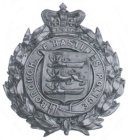
|
Hastings Borough Police History, Beat Book, and Straw Helmets |
||
|
Our thanks to Derek Oakensen for submitting 'The History of Hastings Borough Police, 1836 to 1967' on PDF together with a copy of their 'Book Book, 1935'. Click on either PDF Icon.
Outside the Police Station, High Street, Hastings, 1854. From a Magic Lantern Slide, held at Hastings Library. (Photograph: Flickr)
15th September in 1928, Hastings Police set up a ‘flying-squad’ equipped with powerful motorbikes with sidecars. Police outside Town Hall Queens Road Circa 1928 (Photograph: Historical Hastings)
N.B. Straw helmets were introduced in July 1912, for summer use but weren't that popular as they quickly became mis-shaped after a shower of rain. They were even worn by the crew of the motorcycle combination and two MC combinations were bought in July 1928.
Superintendent William Buddle, inspecting his men before the Kings Parade, 1935.
First motor cars, 1936
|
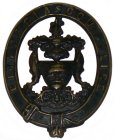
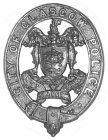
|
Black helmet plates |
|
Back in February I asked "Were there really 'Day and Night' helmet plates? Or is this a Misnomer?" My thanks to all those members who replied. Yes! There were really 'Day and Night' helmet plates. But! There was no 'Hard and Fast' rule.
It depended on the individual force. Some forces chose to wear Black helmets plates, 24 hours a day. Some chose to wear Black for Constables and White Metal for Sergeants. Others chose Black for Night Shifts. Jim
|

|
Tecalemit Security Police |
|
Tecalemit Security Police, 1953
Mark Rothwell is trying to establish the history of the 'Tecalemit Security Police'
Tecalemit was a major employer in Plymouth from 1948 and had a substantial operation at Marsh Mills. The photo clearly implies this private manufacturer of car and aircraft parts had its own constabulary. So far Mark has not been able to find information on this force in the public domain, and has not been able to get the attention of anybody at the current incarnation of the Tecalemit company. An appeal via the Police History Society has provoked some interesting, but inconclusive, discussion, mainly speculation that these were likely men sworn under defence regulations who, over time, lost their police powers but retained the terminology as a private security force. One member of the PHS recalls interacting with men who resembled those in the photo at the Tecalemit factory as recently as the 1980s. I wonder whether any of your members, especially those who worked in Plymouth, recall the Tecalemit Security Police and, if so, could they please contact me?
It would be wonderful to be able to document this police force properly, so it is not forgotten.
Mark can be contact by email mrothwell643@hotmail.co.uk
|

|
'History Matters' |
|
Issue No.32 (February 2022) and 33 (March 2022) of the Devon and Cornwall Police History Magazine by Mark Rothwell are now available online. Included in this issue of the Magazines: Cornwall Constabulary part 2. Chittlehampton Police. Traffic Ephemera. Excerpts from a Cornish Constable’s Casebook. The Long Paw of the Law. The History of the Special Constabulary. Remembering PC Norman Edward West and the Crew of JB141. Police Gallantry & The Wreck of the SS Alba. Christiaan Batelt – The Dutch Police Photographer. My Support Staff Career by Paul Martin.
You can read issue 32 by clicking [HERE] and issue 33 by clicking [HERE] or on the Magazine Covers.
|
Humour from the Sunderland Borough Police 'Facebook' page.
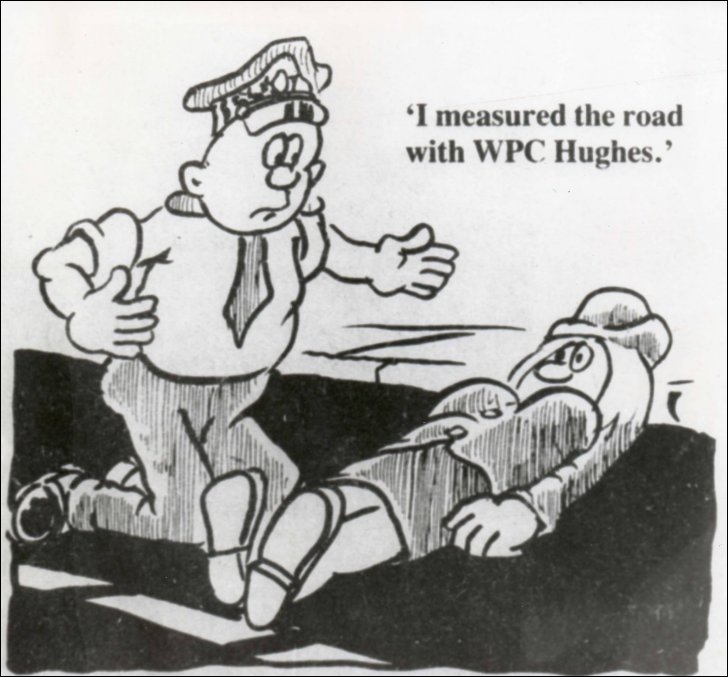

|
Now here's a thought |
|
I am the custodian of a very large number of interesting historical photographs.
A few date from the earliest days of photography. Others are very recent, but are historic by the standards of 2022.
Let me provide an example. In 2002 the Humberside Police took delivery of their second helicopter. The first aircraft had been purchased second hand from the Norwegian air Ambulance Service.
When Humberside purchased "Oscar 99", we used a different kind of lease purchase with various power-by-the-hour agreements and NPAS didn't want it in their fleet. Power by the hour helps with budgeting over the life of an asset because almost all costs are known in advance and there are no nasty surprises for the finance department.
During WWII Falcon Field was No 4 British Flight Training School, where by chance my Uncle was taught to fly.
So there are dozens one-of-a-kind photographs of a helicopter on the production line, being built rivet by rivet, which will never be repeated.
Add to these a collection of around 1,000 archive vehicle images which I was given, that ACPO had collected and which were destined for the incinerator and there are a lot of photographs.
Like FaceBook or loathe FaceBook in particular and Social media in General, it has revolutionised how people with similar interests share things.
What is being done by an increasing number of enthusiasts, is to set up a FaceBook group to share photographs and reminiscences.
It needs little computer skill, unlike setting up a web page. It does require some time though to keep "your" group functioning and to solve the occasional problem member.
In exactly two years time, the Humberside Police will be 50 years old. As of course will all the forces which came into existence on the 1st April 1974.
I've set up a FaceBook group to record the history of Humberside and its predecessor forces, while there are still people who were there before and on Day 1.
There are probably others I have not come across, and there are groups for overseas forces.
Especially as travel is still none too easy, don't write off Social
Media too quickly.
Mention of Humberside Police and member Peter Gilbert's Volvo and Graham Carter's Ford both come to mind/ This is collecting on a grand scale.
|

|
Photo gallery (click on photograph to enlarge) |
|
Monmouthshire Constabulary officers, wearing slouch hats. (Photograph: Ross Mather. Police History Society Museums Section, Facebook Page)
Halifax Borough Police, c.1940 (Submitted by: Alex Jennings)
Halifax Borough Police, Constables; Surguy, Barrett, Young, L.Smith, Bircher, Thompson, Sergeant Gibson. c.1942. (Submitted by: Alex Jennings)
Halifax Borough Police, c.1954 (Submitted by: Alex Jennings)
Halifax Borough Police, Bowls Team,1955 (Submitted by: Alex Jennings) Send your photos to Jim admin@pmcc-club.co.uk |
![]()
|
Police Vehicles of Essex - Part 2 By Brian Homans |
|
|
In this issue of 'Motor Patrolling' we look at the vehicles used by 'Essex Police' which was formed on 1st April 1974, after being re-named from 'Essex and Southend-on-Sea Constabulary'.
Brian
1973-74 (but purchased much later), Leyland Atlantean Crime Prevention Bus
1978-79, Minivan
1979, Ford Granada
1982-83, Ford Sierra
1982-83, Preserved Ford Cortina
1984, Ford Cargo Underwater Search Unit
1985, Ford Cargo Recovery Truck
1985, Ford Transit County 4x4
1986, Ford Cargo Horsebox
1986, Ford Cargo Mobile Control Room
1986-87, Ford Sierra
1987-88, Ford Granada Mark 3
1988, Ford Cargo Recovery Truck
1989, Mercedes G Wagen Traffic Patrol
1989-90, Ford Sierra Estate
1989-90, Range Rover
1989-90, Sponsored Suzuki Vitara, Crime Prevention Unit
1991-92, Ford Transit
1991-92, Ford Transit, Crime Prevention Unit
1991-92, Range Rover
1992-93, Ford Granada Cosworth
1992-93, Sponsored, Mazda 323F, Crime Prevention Unit
1993, BMW K100
1994-95, Ford Escort DL saloon
1994-95, Vauxhall Senator
1995, Jeep Cherokee
1995-96, Land Rover Defender 110
1995-96, Volvo 850 T5
1997-98, Ford Scorpio
2000, Ford Mondeo
2003, Ford Mondeo
2010-11, Volvo Estate Car
2014, Land Rover Discovery, Commercial Vehicle Unit
2018, Volvo V90
2020, Volvo V90 |
|
Finishing off with some humour from Pam's postcards . . . . . .
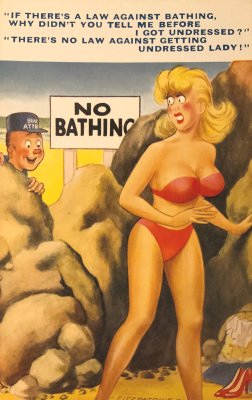

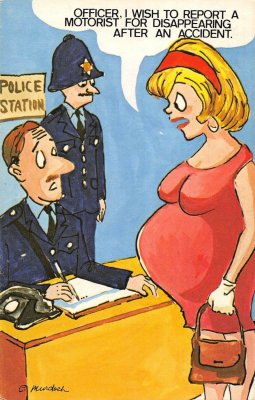

Hover your mouse pointer over a postcard to enlarge it
|
WANTED |
|
Your news, views, stories, pictures from your collection. Any item that you think will be of interest to other collectors. |
Next PMCC Magazine: 1830hrs Friday 27th May 2022
|
|
©PMCC
➤